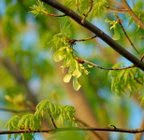
BRYANT PARK
According to R. Terry Schnadelbach in "Ferruccio Vitale Landscape Architect of the Country Place Era", Vitale wrote an article for House and Garden titled "Village Greens for Town Betterment". In it he touted two park types. The village green of Bryant Park and the smaller neighborhood park. The village green was a new prototype for parks.
It wasn't Vitale who actually designed the park, but it is quite clear that his village greens park prototype was the seed for the design. Bryant Park, designed in 1934, wasn't designed until after Vitale's death in 1933. It was designed by his colleague Gilmore Clarke and Lusby Simpson
This scan is from Schnadelbach's "Ferruccio Vitale Landscape Architect of the Country Place Era"

Village greens, plan for a large urban park. A new prototype of an urban park for American cities features a raised, multipurpose grass terrace surrounded by a double rows of trees. Separation from traffic and street noise is provided by low plantings and balustrades. Flagpoles and fountains are used to articulate the entry plazas from the street. A civic building is meant as an urban backdrop. House and Garden, June 1926

Village greens, perspective of a large park. Vitale pictured the civic buildings typical of the traditional New England village as surrounding his new urban green.
Beaux-Arts formality is very evident in this design. Bryant Park today is a highly successful park. It went through some years of decline, locally called 'Needle Park', but it has been embraced by the community and is a very usable and enjoyed park.
Some great links and pictures of the park:
NYC ADDICT
NYC FINEST PUBLIC RESTROOMS
FORGOTTEN NYC STREET SCENES
Listen to Bryant Park
It is at Dust and Rust where I found my favorite picture of the park.

PPS is a great site to read about successful parks and Bryant park is in their top favorites.
Bryant Park Success Story (80% of the credit is given to good management.)
Bryant Park Hall of Shame (Over management story)
PPS Bryant Park
Bryant Park Official Website
Bryant Park Map
Great City Parks by Alan Tate includes Bryant Park in his book of 20 "well-planned, well-designed and well-managed parks". Bryant Park, 'Needle Park', had become an unusable space because of its over-protection and isolation from the street prior to its rehabilitation in the 90s.
The history of Bryant Park tells us to make park space very accessible and friendly from the street. The test of success is measured by the amount of women using the space. This requires safety and security. People want to feel the green space. They want to get away from the crush of pavement and cars. But they need that visible link to the street and the safety of people. High use provides a safer place for the vulnerable. It is hidden spaces and low use spaces that provide congregating spaces for those on the edge.
Again Bryant Park becomes a prototype and model of success through private funding and management of the park which is somewhat controversial because of the amount of privatization. Check out the Bryant Park Hall of Shame Link.

Vitale's park was simple and powerful. A village green for public gatherings surrounded by shade and strolling space. Beaux-Arts in style and a product of the City Beautiful Movement, the village green has great possibilities still today. My favorite aspects of the village green park is the protected edge that allows permeable access and interaction between the street and the promenade area. The center of the park becomes its own entity and space surrounded by a wall of trees. This becomes a stadium, a platform, a parade, a show, an event.

